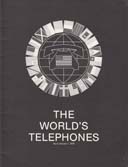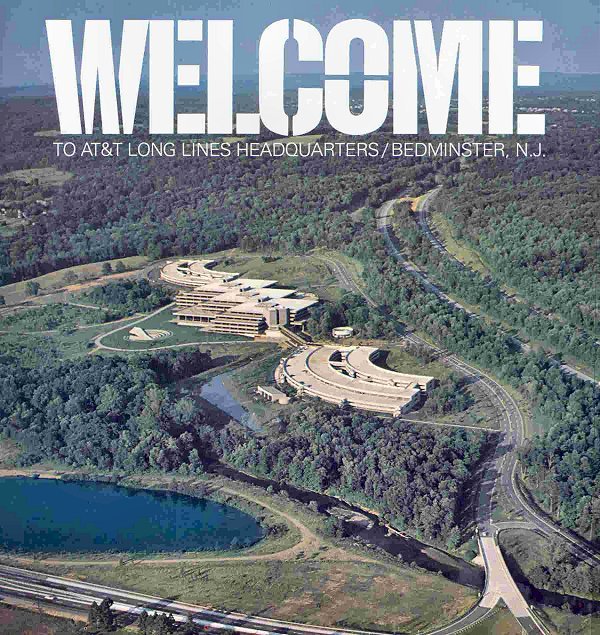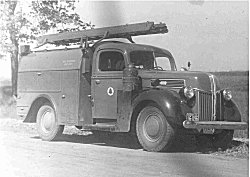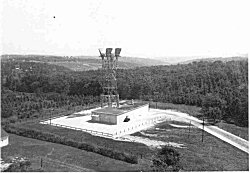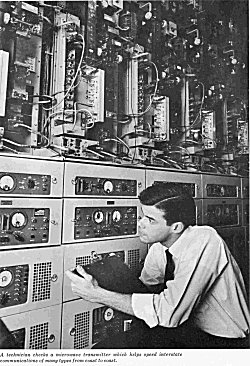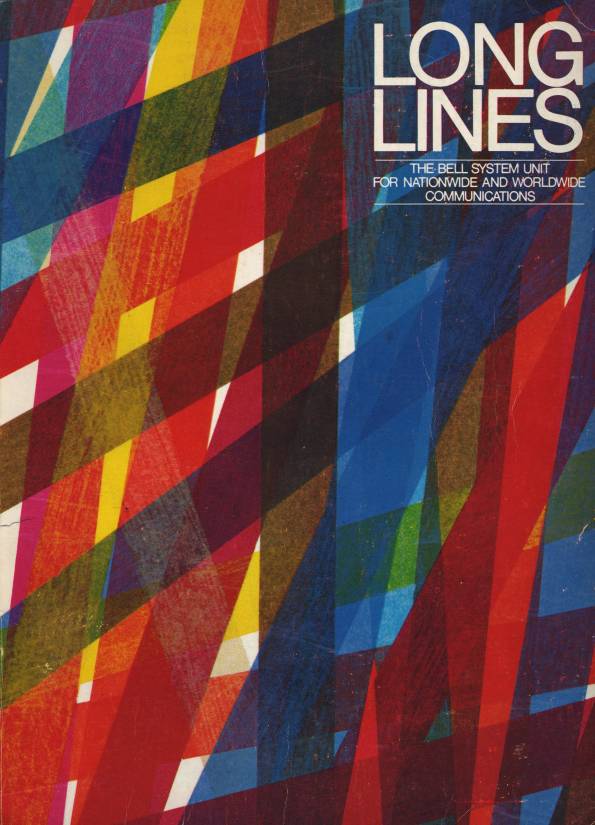(Click on logo above to enlarge)
Introduction
AT&T’s Long Lines department consisted of a network of facilities for nationwide and worldwide communications. Its circuits interconnected the territories of the telephone companies that provide local service throughout the country. With its communications counterparts abroad, Long Lines furnished circuits linking the United States with countries around the globe.
Telephone operators handled all long distance calls until Direct Distance Dialing (DDD) was implemented. Today we rarely use an operator to place a long distance call and most of us don’t appreciate what was involved just 40 years ago in making a long distance call though an operator.
You can hear a typical domestic call in the USA (about 1949) in a old Dragnet TV series show by clicking here. The rock group Pink Floyd had a song called Young Lust whose ending dramatized an international phone call. You can listen to this audio clip by clicking here.
Now for some interesting history of the American Telephone and Telegraph Company’s Long Lines Department . . .

The World’s Telephones, as of 1976, Published by AT&T Long Lines:

We Offer Personalized One-On-One Service!
Call Us Today at (651) 787-DIAL (3425)


CONTENTS:
-
AT&T Long Lines Department TD-2 Microwave Radio Restoration Van
-
Book: “Long Lines - The Bell System Unit For Nationwide and Worldwide Communications” - Published by the Bell System in 1969 - Contributed by Roy Juch for me to scan into electronic format for preservation in this website’s historical archives. Details the AT&T Long Lines department of the Bell System.

Contributions by Roy Juch
Click on photo above to enlarge
Referring to the photo above, the AT&T Long Lines Headquarters was at 32 Ave of the Americas in NY but that location was also an equipment location so both required more space. AT&T Long Lines Headquarters then moved to Bedminster, NJ in 1977.
AT&T Headquarters at 195 Broadway also outgrew its space and moved (mostly operational folks) to “295” which was in near by Basking Ridge, NJ. It’s really strange to me that now AT&T has sold 195 & 295 and moved into Bedminster and 32 Ave of the Americas. In the final analysis what remains of AT&T now is really the Long Lines Department of the old AT&T!
- Roy Juch
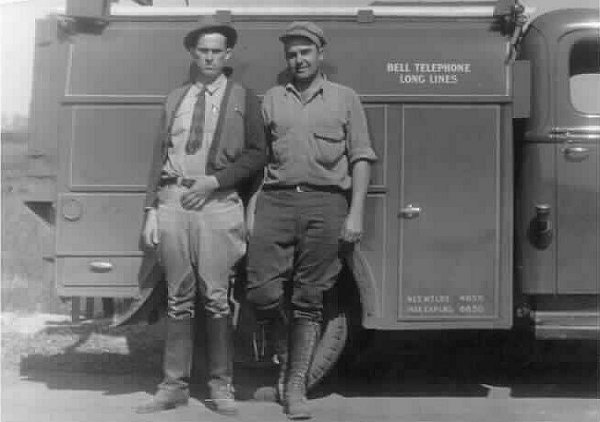
The photo above was sent to me by Roy Juch. His description of the photo follows:
a picture of two Linemen standing next to a Long Lines-Bell Telephone truck. The fellow on the left (with the tie) is the Foreman Floyd Evans. The fellow on the right is my father, the ‘helper’, Roy Juch, Sr.. This pix was taken about 1940 + or - in probably mid Missouri on an Open Wire Line they were either constructing or repairing. Notice the high boots which beside snake protection facilitated the wearing of the ‘climbers’.
Full view of truck Click on photo above to enlarge
Microwave Radio Tower - Click on photo above to enlarge
This is a pix of the Hollister, MO Radio Relay Building & Tower taken in about 1968. I was the supervisor at this location between 1966-1968. The location is just south of Branson, MO and still in use today although used for digital radio not analog radio relay. A half dozen technicians worked out of this location maintaining smaller microwave relay stations along the St. Louis-Dallas Radio Relay Route.
- Roy Juch.
Click on photo above to enlarge
This is a picture of a TD-2 Radio Repeater. This is typical of equipment in most all ‘Microwave Repeater stations’ like the Hollister above. It takes a weak analog signal in the 3.7 to 4.2 gigahertz band coming in from the receiving cornucopia antenna on the receiving waveguide, amplified the signal and sent it on to the transmitting waveguide and antenna system. Tens of Thousands of these “repeaters” were in service at thousands of repeater stations all over the U.S. and many foreign countries. Each repeater was improved to eventually carry at least 1200 voice circuits, or one television channel. At one time Long Lines provided all the television distribution for all the television networks. Prior to television over the microwave radio it was provided by Long Lines via coaxial cable on B2 (Black & White) terminal equipment and later on B3 (color) terminal equipment.
- Roy Juch.

AT&T Long Lines Truck Click on photo above to enlarge
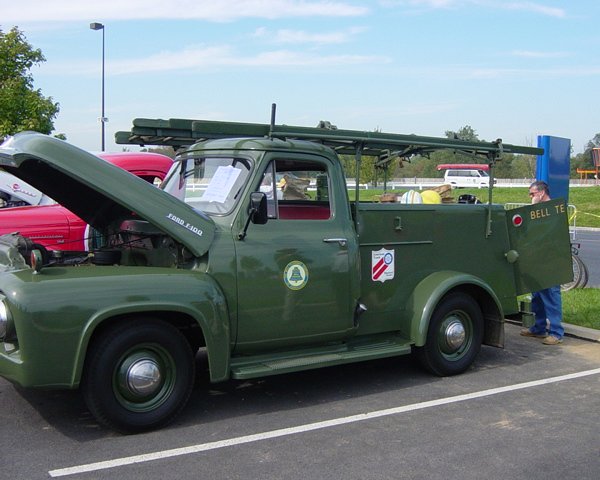
Photo above taken during the Antique Car Show held in Hershey, PA every year in October. Photo submitted by John Ford

AT&T Long Lines Department
TD-2 Microwave Radio Restoration Van
(compiled by Larry Douglas)
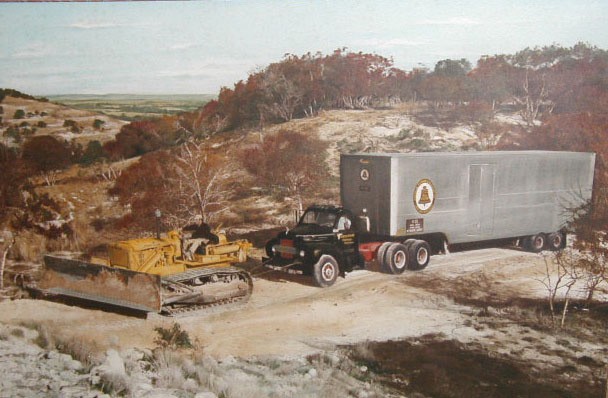
AT&T Long Lines Department TD-2 Microwave Radio Restoration Van
SUMMARY - Dated 5-9-04
This is a picture of an AT&T Long Lines Department TD-2 Microwave Radio Restoration Van. This van is about half way up to the top of a granite toped mountain that is located about half way between, and in the line of sight with Lyndon B Johnson’s Ranch near Stonewall Texas, and Austin Texas. The trail, or road up the mountain had to be upgraded before the truck could be towed up the mountain.
Lyndon B. Johnson became president after John F. Kennedy was assassinated on Nov. 22, 1963. When LBJ was to entertain his first foreign visitor, he requested television coverage at the ranch. This picture was taken during the provision of that service. It is estimated that this picture was taken in early 1964.
Myrl Bridgewater Retired Long Lines District Operations Manager from St Louis Mo. recalls this historical event quite well:
Some of us were attending a meeting (a one day meeting in Omaha) to become familiar with SAC (Strategic Air Command). (We were equipped with one-night overnight bags) John Barteck and I, along with a couple of other folks, were called out of the meeting and were told we were to go to Texas on a RUSH mission to construct a TD2 system between Johnson’s ranch and Austin, Texas.
Johnson was already president. The purpose of the rush was because Johnson was to entertain a visiting dignitary from a foreign country. He wanted television coverage at the ranch. It had to be done within about 60 hours. Southwestern Bell said it could not be done. The Long Lines Operations VP, Earl Schoolley, said Long Lines could do lt. We were given an “open check book.”
When I said, I would go to St. Louis for my clothes; I was handed a plane ticket to Austin and told there was no time for St. Louis. I was in charge of the ranch site, about two hundred yards from the ranch house, and John Bartech was in charge of the site between the ranch and Austin. Walt Peterson was in my crew.
John Barteck’s site was on top of a granite peaked mountain about halfway between the ranch and Austin. The first evening they were there, they drilled into the granite and set off a dynamite charge. The next morning an inspection revealed the holes were the same size as the drill bits. The tower anchors were placed in those holes.
The picture was taken of the van being towed up the hill to Bartech’s site. It was about half way up the hill.
We had the TD2 system up and working within 48 hours. We had to, as our hides were on the line. Schooley was not known of being forgiving. After all we only worked about 40 of those 48 hours.
After 3 or 4 days those overnight bags were about gone. We did go to town to buy clean clothes. I was going to buy jeans and work shirts, but Walt Peterson said “OH, no you don’t”. By G–, you are our manager, and you must dress like it. I bought white shirts.
We spent the better part of to two weeks there. The secret service men were real gentlemen. After two days they were calling me by my name. I could go on to the ranch and take visitors with me, when they recognized me. Some of the visitors were: Bob Huber, Todd Esery, and others. (We were not allowed into the house as Lady Bird was living there).
Larry, thank you for reminding me of this episode, as it was one of the most interesting of my 41+ year career.
Myrl Bridgewater
This picture represents the ability of the Long Lines department of AT&T to restore, or provide temporary TD-2 microwave radio facilities, on a relatively instantaneous basis. This capability did not occur over night; it came about as the result of a lot of dedicated Long Lines employees. Walt Peterson Midwestern Area staff Supervisor, and his counterparts in the Transmission, and outside plant engineering groups had been working on the Idea for some time, but it was difficult to get the necessary budget authorizations to put them into service.
As is to often the case, a drastic situation has to occur that requires such a capability, before all parties are convinced that is required.
Such a situation occurred on Sunday morning May 28, 1961 when a small radical organization who called them selves “The American Republican Army” blew up TD-2 microwave radio stations at Wendover Nevada, and Cedar Mountain Utah, and a K carrier repeater station at Knolls Utah. This shut down the central transcontinental TD-2 and K carrier facilities. (SEE RELATED STORY below)
After this crisis was restored and construction of new stations underway, a pair of semi truck vans were equipped with all power and equipment and tower sections necessary to put up a TD-2 repeater station in just a matter of hours. Practice restoration exercises were performed in each region to assure a competent restoration crew could be assembled in a short time wherever they were needed.
Additional vans were equipped and stored in Key locations across the country.
This capability was put to use several times over the years restoring towers that were blown over by tornados, as well as providing remote network television coverage for special events and circumstances.
(RELATED STORY)
NEWS FLASHES AT THE TIME:
SERVICE QUICKLY RESTORED AFTER REPEATER STATION BLASTS
Early Sunday morning, May 28,1961 the TD-2 repeater stations at Wendover, Nevada and Cedar Mountain, Utah, and the K repeater station at Knolls, Utah were blown up and virtually destroyed, interrupting both the central transcontinental microwave and K-carrier routes. More than 2200 telephone and telegraph circuits and four television channels were interrupted.
Two thirds of the telephone circuits, all critical services and all TV and radio circuits were made good by rerouting within A few hours after the blasts. The radio systems were rerouted around the damaged section by way of Los Angeles within two hours. By Sunday evening all circuits affected by the explosions had been made good, using spare facilities and protection radio channels. Pre-arranged emergency service restoration plans worked smoothly. In less than 30 minutes after word was received, men and materials were moving to the three stations. Portable microwave equipment and truck-mounted towers were flown to the two radio relay locations. Despite the high number of circuits blanked out, the effect on traffic was light. Many military private line circuits were not affected at any time by the explosions because of alternate routings.
Also, many other private line circuits were individually rerouted with minimum delays. One two-way TD-2 channel was made available between Salt Lake City Junction and Los Angeles Tuesday night, May 30, by Expediting installation of new channels that were nearing completion. This released some of the protection channels that had been used for reroutes. Portable TE microwave equipment was brought in to restore service across the breaks. By June 2 four TE channels had been set up, two for message service, one for TV, and one for protection.
Five K-1 systems were restored by cutting the cable through at Knolls and using additional amplifiers at the adjacent stations. Temporary buildings have been constructed at the three sites, and a temporary installation of TD-2 equipment has been made at the two radio sites to serve until permanent rebuilding can be done. This installation was completed by June 4.
Permanent restoration is expected to be completed at all three locations before September 1. As a precautionary measure, National Guardsmen had been posted quickly at all unattended K-carrier and radio-repeater stations in the area. They were replaced by Bell System guards a few days later. Many normally unattended stations in Utah, Nevada and California are continuing to be attended or guarded.
Personal note:
" I was working in Salt Lake at the time, and seen the damage first hand.
The FBI was at the sites within in a couple hours, and determined what kind of explosive had been used what quantity had been used, and where it was purchased, within a very short period. The people were tracked to California, and were apprehended within 2 or 3 days. The group called themselves “The American Republican Army” See Joe Gibson’s recount below."
“The Explosion at Knolls K station was so strong, that the only thing that was left was the floor slab. The Emergency diesel engine was blown 50 to 60 yards out into the flat.”
“The Towers were not just blown over, a charge was set on each of the tower legs about a third of the way up, and detonated at exactly the same instant. The result was the lower part of the legs spread open and let the upper part of the tower drop straight down inside the bottom section still standing upright. This dropped the antenna below the line of site signal. This also made it more difficult to erect a new tower, as the old one had to be unassembled and removed first.” - Larry Douglas
Joe Gibson recalls:
“I was either the Dist Plant Supervisor or Dist Plt Supt in Dallas at the time of some or all of these events. I believe John Bartek was the Dist Plt Supt in Albuquerque in answer to the question mark by his name.”
“My recollection is that the leader of the so-called ‘army’ was caught in his boat, along with weapons and munitions, somewhere along the Mexican coast. He was later identified as a disgruntled contractor who was terminated by Southwestern Bell in Houston and he alleged that the event destroyed his business, as like a lot contractors, he depended on that one contract too much. I recall that ATT and Southwestern Bell officials later had to testify at his parole hearings to oppose his release from prison. His main operative was a soldier of fortune who was simply hired to do the dirty work. It would be interesting to chronicle some of the very humorous events that surrounded the aftermath, when we were all told to hire guards for all of our tower and repeater locations. We hired private security firms, off-duty sheriffs and police and there were a lot of wild stories and events regarding some of their activities. It was like scenes from a keystone cops movie.” - Joe Gibson
PS Ross Dyer was assigned to spend some time at the LBJ ranch and has some very amusing story about LBJ and Mrs. Johnson. LBJ was very hard of hearing and complained that his television sets, multiple ones tuned to the various networks, were not loud enough due to poor transmission. Ross stated that they were so loud it was deafening to everyone but LBJ.

Roy Juch sent this nice book, published in 1969, on AT&T Long Lines to scan for the website. To go to the table of contents and read the online version of this book, click on the front cover image above or click HERE.

Long Lines related website links that are not part of this website:
The Microwave Radio and Coaxial Cable Networks of the Bell System
Here’s a page about the Richmond, VA CAPAR “Flying Squad” which handled coaxial-cable breaks: http://long-lines.net/tech-equip/coaxial/FlyingSquad.html
and photos of repair work on a damaged river-crossing coaxial cable: http://long-lines.net/tech-equip/coaxial/L3Splice.html
AT&T Long Lines Microwave Towers
http://www.drgibson.com/towers





Reliable, secure high-speed internet
With CenturyLink Simply Unlimited Internet, you can choose from a wide range of available speeds that fit your online needs. Plus, you can connect several devices with super-fast in-home WiFi.
Order Now


